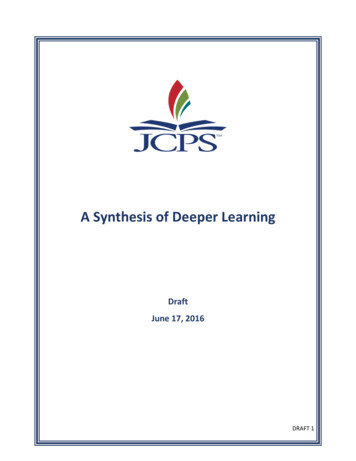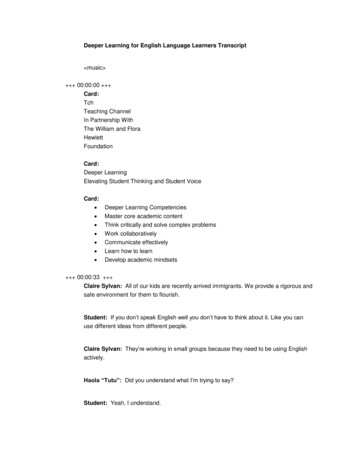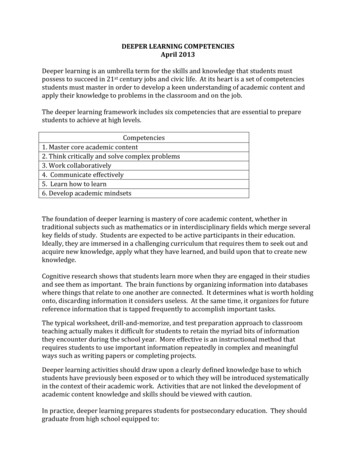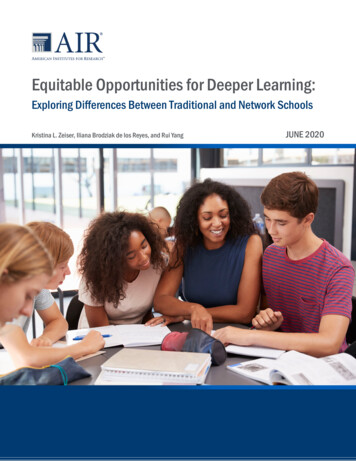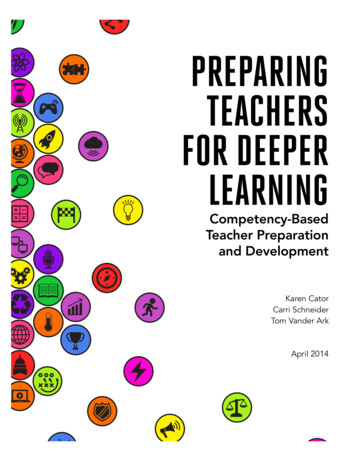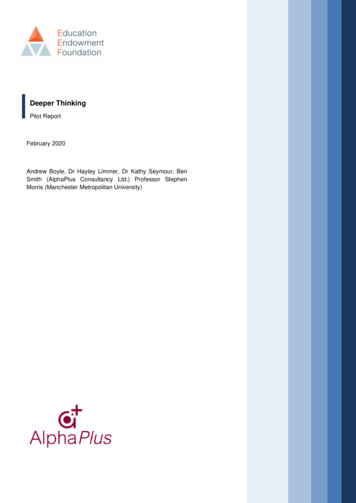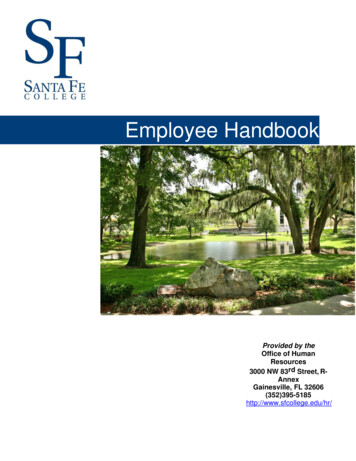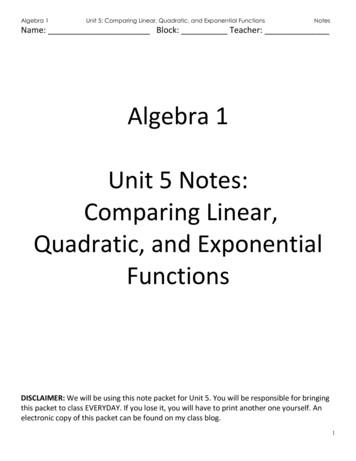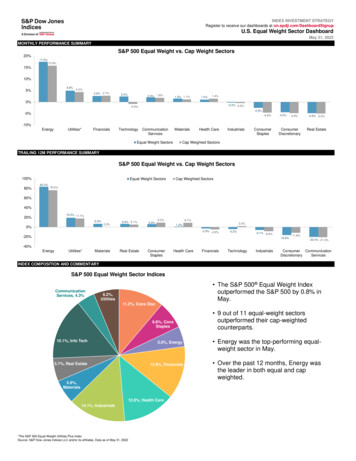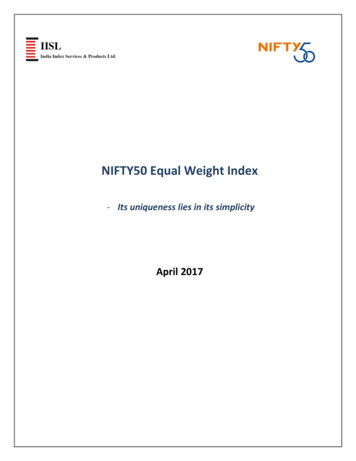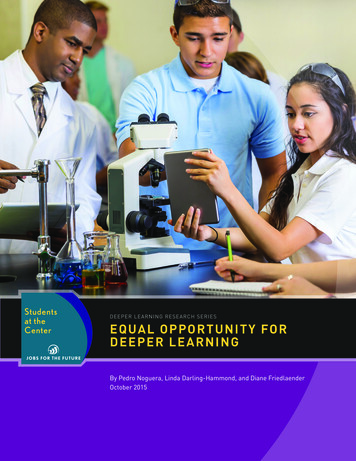
Transcription
DEEPER LEARNING RESEARCH SERIESEQUAL OPPORTUNITY FORDEEPER LEARNINGBy Pedro Noguera, Linda Darling-Hammond, and Diane FriedlaenderOctober 2015JOBS FOR THE FUTUREi
EDITORS’ INTRODUCTION TOTHE DEEPER LEARNING RESEARCH SERIESIn 2010, Jobs for the Future—with support from the Nellie Mae Education Foundation—launched the Students at the Centerinitiative, an effort to identify, synthesize, and share research findings on effective approaches to teaching and learning atthe high school level.The initiative began by commissioning a series of white papers on key topics in secondary schooling, such as studentmotivation and engagement, cognitive development, classroom assessment, educational technology, and mathematics andliteracy instruction.Together, these reports—collected in the edited volume Anytime, Anywhere: Student-Centered Learning for Schools andTeachers, published by Harvard Education Press in 2013—make a compelling case for what we call “student-centered”practices in the nation’s high schools. Ours is not a prescriptive agenda; we don’t claim that all classrooms must conform toa particular educational model. But we do argue, and the evidence strongly suggests, that most, if not all, students benefitwhen given ample opportunities to: Participate in ambitious and rigorous instruction tailored to their individual needs and interests Advance to the next level, course, or grade based on demonstrations of their skills and content knowledge Learn outside of the school and the typical school day Take an active role in defining their own educational pathwaysStudents at the Center will continue to gather the latest research and synthesize key findings related to studentengagement and agency, competency education, and other critical topics. Also, we have developed—and have madeavailable at www.studentsatthecenterhub.org—a wealth of free, high-quality tools and resources designed to help educatorsimplement student-centered practices in their classrooms, schools, and districts.Further, and thanks to the generous support of The William and Flora Hewlett Foundation, Students at the Center hasexpanded its portfolio to include an additional and complementary strand of work.The present paper is part of our new series of commissioned reports—the Deeper Learning Research Series—which aim notonly to describe best practices in the nation’s high schools but also to provoke much-needed debate about those schools’purposes and priorities.In education circles, it is fast becoming commonplace to argue that in 21st-century America, each and every student mustaim for “college, career, and civic readiness.” However, and as David Conley described in the first paper in this series, alarge and growing body of empirical research shows that we are only just beginning to understand what “readiness” reallymeans. Students’ command of academic skills and content certainly matters, but so too does their ability to communicateeffectively, to work well in teams, to solve complex problems, to persist in the face of challenges, and to monitor and directtheir own learning—in short, the various kinds of knowledge and skills that have been grouped together under the bannerof “deeper learning.”What does all of this mean for the future of secondary education? If “readiness” requires such ambitious and multidimensional kinds of teaching and learning, then what will it take to help students become genuinely prepared for life afterhigh school, and what are the implications for policy and practice?iiDEEPER LEARNING RESEARCH SERIES EQUAL OPPORTUNITY FOR DEEPER LEARNING
We are delighted to share this installment in the Deeper Learning Research Series, and we look forward to theconversations that all of these papers will provoke.To download the papers, executive summaries, and additional resources, please visit the project website:www.jff.org/deeperlearning.Rafael Heller, Rebecca E. Wolfe, Adria SteinbergJobs for the FutureIntroducing the Deeper Learning Research SeriesPublished by Jobs for the Future New and forthcoming titles, 2014–15A New Era for Educational AssessmentDavid T. Conley, EdImagine Strategy Group and theUniversity of Oregon (October 2014)The Role of Digital Technologies in Deeper LearningChris Dede, Harvard Graduate School of Education(December 2014)Let’s Get Real: Deeper Learning and the Power ofthe WorkplaceNancy Hoffman, Jobs for the Future (February 2015)Civic Education and Deeper LearningPeter Levine & Kei Kawashima-Ginsberg, Tufts University(February 2015)Deeper Learning for Students with DisabilitiesLouis Danielson, American Institutes for Research &Sharon Vaughn, University of Texas (August 2015)Equal Opportunity for Deeper LearningPedro Noguera, Teachers College, Linda-DarlingHammond, Stanford University, & Diane Friedlaender,Stanford Center for Opportunity Policy in Education(October 2015)How School Districts Can Support Deeper Learning:The Need for Performance AlignmentMeredith I. Honig & Lydia Rainey, University ofWashington (October 2015)The Why, What, Where, and How of Deeper Learningin American Secondary SchoolsJal Mehta & Sarah Fine, Harvard Graduate School ofEducationThe Implications of Deeper Learning for AdolescentImmigrants and English Language LearnersPatricia Gándara, UCLA Graduate School of Education &The Civil Rights Project at UCLADeeper TeachingMagdalene Lampert, Boston Teacher Residency and theUniversity of MichiganEffective Schools for Deeper Learning:An Exploratory StudyRafael Heller & Rebecca E. Wolfe, Jobs for the FutureJOBS FOR THE FUTUREiii
Jobs for the Future works with our partners to designand drive the adoption of education and career pathwaysleading from college readiness to career advancement forthose struggling to succeed in today’s economy. We workto achieve the promise of education and economic mobilityin America for everyone, ensuring that all low-income,underprepared young people and workers have the skillsand credentials needed to succeed in our economy. Ourinnovative, scalable approaches and models catalyze changein education and workforce delivery systems.Students at the Center—a Jobs for the Future initiative—synthesizes and adapts for practice current research on keycomponents of student-centered approaches to learning thatlead to deeper learning outcomes. Our goal is to strengthenthe ability of practitioners and policymakers to engage eachstudent in acquiring the skills, knowledge, and expertiseneeded for success in college, career, and civic life. Thisproject is supported generously by funds from the Nellie MaeEducation Foundation and The William and Flora ER.ORGABOUT THE AUTHORSPedro Noguera is the Peter L. Agnew Professor of Education at New York University. Dr. Noguera is a sociologist whosescholarship and research focuses on how schools are influenced by social and economic conditions and demographictrends. He holds faculty appointments in the departments of Teaching and Learning and Humanities and Social Sciencesat the Steinhardt School of Culture, Education and Development. He also serves as a faculty member in NYU’s Departmentof Sociology and is the Executive Director of the Metropolitan Center for Research on Equity and the Transformation ofSchools. From 2008–2011, he was an appointee of the Governor of New York to the State University of New York (SUNY)Board of Trustees. In 2014, he was elected to the National Academy of Education.Linda Darling-Hammond is Charles E. Ducommun Professor of Education at Stanford University. She is Faculty Directorof the Stanford Center for Opportunity Policy in Education and former president of the American Educational ResearchAssociation. Her research and policy work focus on educational and teaching equality and school reform. In 2008, sheserved as director of President Obama’s education policy transition team. Her book, The Flat World and Education: HowAmerica’s Commitment to Equity will Determine our Future, received the coveted Grawemeyer Award in 2012. Her mostrecent book, Beyond the Bubble Test: How Performance Assessments Support 21st Century Learning was released in 2014.Diane Friedlaender is a Senior Associate at the Stanford Center for Opportunity Policy in Education, where she overseesresearch and professional development efforts. The studies she has led at SCOPE are: High Schools for Equity: PolicySupports for Student Learning in Low-Income Communities of Color and Windows on Conversions, a multimediaexploration of redesign at four comprehensive high schools. She previously taught sociological and multiculturalfoundations in education and has also conducted research on school reform models, youth intergroup relations, and youthdevelopment. She earned her BA from UC San Diego and PhD in Education Policy from UCLA.This report was funded by The William and Flora Hewlett Foundation.This work, Equal Opportunity for Deeper Learning, is licensed under a Creative Commons Attribution 3.0 United StatesLicense. Photos, logos, and publications displayed on this site are excepted from this license, except where noted.Suggested citation: Noguera, Pedro, Linda Darling-Hammond, & Diane Friedlaender. 2015. Equal Opportunity for DeeperLearning. Students at the Center: Deeper Learning Research Series. Boston, MA: Jobs for the Future.Portions of this paper are based on the report: Noguera, P., L Darling-Hammond, & D. Friedlaender. 2014. Equity and DeeperLearning. Berkeley, CA: Partners for Each and Every Child, University of California at Berkeley.Cover photography copyright iStockphoto/Steve Debenport
TABLE OF CONTENTSINTRODUCTION1RESOURCE EQUITY FOR DEEPER LEARNING3WHAT EDUCATORS NEED TO KNOW TO ENABLE DEEPER LEARNING6SCHOOLS THAT ENACT DEEPER LEARNING8POLICY IMPLICATIONS16ENDNOTES20REFERENCES21JOBS FOR THE FUTUREv
viDEEPER LEARNING RESEARCH SERIES EQUAL OPPORTUNITY FOR DEEPER LEARNING
INTRODUCTIONOut of concern that the nation’s schools—particularly those working with traditionally underservedpopulations—are not adequately preparing all students to succeed in college and careers, educationpolicymakers have launched a series of major reform efforts in recent years. Among the mostprominent are two initiatives that call for fundamental changes in the areas of curriculum andassessment.The first is the development of the Common Core StateStandards, which aim to improve upon the “mile wide, inchdeep” curriculum guides of the past by replacing themwith a set of “fewer, higher, and deeper” learning goals.These learning goals emphasize critical thinking, analyticskills, and other deeper learning competencies, such as theability to apply core academic content, work collaboratively,communicate effectively, and learn how to learn (Pellegrino& Hilton 2012).Because the existing school accountability system does notmeasure these learning goals, the second initiative aims todevelop complex forms of assessment that can support andevaluate student progress toward meeting the new collegeand career-ready standards. Until now, most states haverelied on multiple-choice tests that primarily measure lowlevel recall and recognition skills (Yuan & Le 2012). However,two consortia of states—the Partnership for Assessmentof Readiness for College and Careers (PARCC) and theSmarter Balanced Assessment Consortium (SBAC)—havecreated new assessments, mapped to the Common Core,that include more open-ended tasks and complex problems,and will provide much richer information about studentmastery of higher-order skills.While promising, these initiatives will require many schoolsto transform their teaching methods, organizationalsystems, and approaches to leadership. Undoubtedly, thesechanges will be particularly challenging for schools thatserve large numbers of “high need” students (e.g., Englishlanguage learners, students with disabilities, and overage and undercredited students). Many of these schoolshave already been struggling to meet the lower standardsthat have been in place for over two decades. Now, as theacademic bar rises, they could see a massive increase in thenumbers of students deemed to be failing.To help students meet the new standards, schools willneed to provide regular opportunities to practice highlevel skills such as solving complex problems, conductingresearch, communicating in multiple forms, and using newtechnologies to find, analyze, and evaluate information.However, when it comes to creating such a rich learningenvironment, schools serving low-income students andstudents of color tend to have the furthest distance totravel.Over the last 15 years, since the passage of the No ChildLeft Behind Act (NCLB), schools serving relatively affluentTo help students meet the new standards, schools will need to provideregular opportunities to practice high-level skills such as solvingcomplex problems, conducting research, communicating in multipleforms, and using new technologies to find, analyze, and evaluateinformation.JOBS FOR THE FUTURE1
students have continued to offer rigorous instruction(particularly in their honors, Advanced Placement, andcollege prep courses) and a wide course selection, includingworld languages, science, history, music, and the arts. Incontrast, schools serving underprivileged students, alreadyunderresourced, have struggled to maintain a broadcurriculum in the face of budget cuts. Many have shiftedsignificant amounts of classroom time to test preparationin an effort to boost student performance on high-stakesexams (Au 2007; McMurrer 2007).Complicating matters further, the segregation of studentson the basis of race and socio-economic status hasintensified over the last thirty years (Civil Rights Project2014). While dropout rates have declined recently, theyremain extremely high in some parts of the country,widespread disparities and defined an equity agenda toaddress the following needs: the need to restructure the school finance system toensure equitable distribution of resources the need to ensure access to quality teachers the need to ensure access to high-quality earlychildhood education the need for external supports to address the socialneeds of children the need for a new accountability system to holdpolicymakers responsible for conditions within schoolsThis report addresses the issue of equity in another crucialdimension: teaching and learning. We argue that to ensureparticularly in urban areas. As of 2011, 25 percent of thenation’s African American high school students and 17percent of Latino high school students were enrolled inwhat some call “dropout factories”—schools that see theirenrollment decline by 40 percent or more between ninthand twelfth grade; only 5 percent of white students attendsuch high schools (Balfanz et al. 2013).equity in access to deeper learning, practices and policiesmust address the context for education both outside andinside of schools. To enable low-income students to learndeeply and successfully, schools that serve them must offera high-quality instructional experience and the wraparoundservices that can help ameliorate the stressful conditionsthey experience in their communities.In short, successful implementation of these major newpolicy initiatives will need to overcome inequities in funding,learning opportunities, and learning conditions that arepervasive in the American educational system and thatcontribute to the persistence of the so-called “achievementgap.”To inform efforts to prepare greater numbers of studentsfor college, careers, and civic life, we first describe theobstacles that currently prevent schools from deliveringhigh-quality instruction. We then examine educationalmodels, structures, and practices that facilitate deeperlearning. Finally, we take a wider systemic perspective toconsider how policy, practice, and research can be alignedto support the development of pedagogy for deeperlearning in schools serving students who have been placedat risk of school failure.In a recent report to the U.S. Secretary of Educationentitled For Each and Every Child: A Strategy forEducational Equity and Excellence (2013), the NationalCommission on Excellence and Equity documented theseSuccessful implementation of these major new policy initiatives willneed to overcome inequities in funding, learning opportunities, andlearning conditions.2DEEPER LEARNING RESEARCH SERIES EQUAL OPPORTUNITY FOR DEEPER LEARNING
RESOURCE EQUITY FOR DEEPERLEARNINGIn this paper, we define equity as the policies and practices that ensure that every student hasaccess to an education focused on meaningful learning (i.e., that teaches the deeper learning skillscontemporary society requires in ways that empower students to learn independently), taughtby competent and caring educators who are able to attend to the student’s social and academicneeds, and supported by adequate resources that provide the materials and conditions for effectivelearning (Darling-Hammond et al. 2014). Equity-based reforms in teaching and learning will becentral to the effort to expand access to deeper learning.For many years, critics of the accountability movement haveargued that its emphasis on narrowly framed academicgoals has made it more difficult to pursue deeper learningwith students. Even before the adoption of NCLB, advocatessuch as Ted Sizer, author of Horace’s Compromise andthe founder of the Coalition of Essential Schools, arguedthat the high school curriculum had become little morethan an amalgamation of scattered facts and skills, lackingcoherence and more likely to elicit boredom than seriousengagement. As an alternative, Sizer and others called foreducators to choose “depth over breadth” by emphasizinginstruction in critical thinking, problem solving, and other“habits of mind” that would foster lifelong learning as wellas the ability to acquire and use knowledge to tackle newproblems and develop new ideas, products, and possibilities.For a number of reasons, advocates for such teaching andlearning never gained much traction in schools servingchildren of color in areas where poverty was concentrated.Harvard Education Professor Jal Mehta (2014) recentlysuggested that advocates of deeper learning have a “raceproblem,” in that the practice of “deeper learning in the U.S.is much more white than the nation as a whole.” He goes onto add that many educators and civil rights advocates havebeen skeptical of calls for deeper learning and, as a result,“students in more affluent schools and top tracks are giventhe kind of problem-solving education that befits the futuremanagerial class, whereas students in lower tracks andhigher-poverty schools are given the kind of rule-followingtasks that mirror much of factory and other working classwork.”While it is true there is a divide, there is a long traditionof support for deeper learning in the black community.Since the days when W.E.B. DuBois and his colleagues inthe NAACP argued for a liberal arts curriculum for AfricanAmerican students, civil rights groups have fought againstthe lower-level, skills-based curriculum that society hastypically reserved for students of color. Only in the lastdecade have accountability hawks cloaked arguments fortest-based reform in civil rights language, even as theeffects of those reforms have deepened the gulf betweenthe curricula offered to the haves and the have-nots.As an alternative, Sizer and others called for educators to choose“depth over breadth” by emphasizing instruction in critical thinking,problem solving, and other “habits of mind” that would foster lifelonglearning as well as the ability to acquire and use knowledge to tacklenew problems and develop new ideas, products, and possibilities.JOBS FOR THE FUTURE3
While the No Child Left Behind Act brought a neededmeasure of attention to the achievement of often-neglectedgroups of students, high-stakes testing has inadvertentlyreinforced long-standing tracking systems based onassumptions about differential ability and the future liferoles of students. This has occurred because (1) in manyschools, especially those serving low-income students, thecurriculum has been narrowed to mirror the tests; and (2)test scores have been used to allocate differential access tothe curriculum, with the result that students of color andlow-income students have often been denied access to athinking curriculum and instead relegated to remedial, roteoriented, and often scripted courses of study.In short, recent policies have created a vicious cycle thatexacerbates existing inequities. Evidence suggests thateven when these policies do lead to a momentary bump inscores on low-level tests of basic skills, the lack of accessto a broad liberal arts curriculum and to opportunities toengage in complex problem solving ultimately contributesto poor performance on gateway tests for college (i.e.,ACT and SAT) and in college courses that require deepercomprehension skills and higher-order thinking (Conley2014).To the degree that deeper learning remains unavailableto students of color and children of low-income families,America will never be able to solve its equity dilemma. Theevidence is clear: students will only acquire the skills tobe truly college and career ready if they have access to ahigher-level curriculum.The Effects of Poverty and the EnvironmentEducators have long understood that environmentalfactors—related to family background, peer groups,neighborhood conditions, and more—influence the health,nutrition, safety, and overall psychological and emotionalwell-being of young people, which in turn affect theirdevelopment and learning (Rothstein 2004).As numerous studies have shown, family income andparental education are two of the strongest predictors ofstudent achievement and educational attainment (Colemanet al. 1966; Goldhaber et al. 1999; Jencks 1972; Jencks &Phillips 1998; Kahlenberg 2011). Children in schools wherepoverty is concentrated underperform their counterpartsin more economically mixed settings. Indeed, students whoare not low-income have lower achievement in high-povertyschools than low-income students attending more affluentschools (National Center for Education Statistics 2004).Poverty also limits the amount and quality of academic andsocial support students receive outside of school. Whereasmiddle-class parents can generally provide their childrenwith a broad range of opportunities—such as qualitypreschool, summer camp, homework assistance, musiclessons, and the like—that support healthy developmentand enhance the likelihood of academic success (Lareau2003), lower-class parents typically lack the education andresources needed to do so.Further, as poverty rates have risen in recent years, agrowing number of researchers have drawn attentionto the ways in which food insecurity, poor prenatal care,poor heath, lack of safety, housing instability, violence,and pervasive and persistent stress negatively influencechildren’s welfare and well-being (Adelman & Taylor 1999;Syme 2004; Rothstein 2004; Eccles & Gootman 2002;Noguera & Wells 2011). Many have argued that the rise inchildhood poverty rates since the 1980s has been a majorreason for the lack of progress in improving Americanschools, as federal and state education policies have donelittle to redress what has become an increasingly tatteredsafety net (Barton & Coley 2010). By 2007, according to alarge-scale study on child health and well-being conductedby the United Nations Children’s Fund, the U.S. ranked 24thout of the 25 wealthiest nations.The educational consequences of poverty appear early.Studies have found, for example, that the workingvocabulary of four-year-old children from low-incomefamilies is approximately one third the size of that ofchildren from middle-income families (Hart & Risley1995), which makes it more difficult for them to read withcomprehension and engage in academic learning when theyenter school. By first grade, only half as many studentsfrom low-income families are as proficient as students frommore affluent families at understanding words in contextand engaging in basic mathematics (Denton & West 2002).1To the degree that deeper learning remains unavailable to students ofcolor and children of low-income families, America will never be ableto solve its equity dilemma.4DEEPER LEARNING RESEARCH SERIES EQUAL OPPORTUNITY FOR DEEPER LEARNING
communities is typically higher than in poor ones (EEC 2013;Baker et al. 2013; Darling-Hammond 2010). The differencesare dramatic in many states, with wealthy suburban schoolsspending twice as much as urban and rural schools thatserve higher-need students.of teachers to teach the more sophisticated curriculumneeded to develop higher-order thinking skills in students.that in districts that substantially increased their spendingas a result of court-ordered changes in school finance, lowincome children were significantly more likely to graduatefrom high school, earn livable wages, and avoid poverty inadulthood (Jackson et al. 2014). For low-income studentswho spent all 12 years of school in districts that increasedspending by at least 20 percent, graduation rates rose by23 percentage points and educational attainment levelsrose by a full year. Between the ages of 25 and 45, thesesame children were 20 percent less likely to fall into povertyduring any given year. Their individual wages were 25percent higher than they would have been, and their familyincomes were 52 percent higher. The effects were largeenough in some cases to eliminate the entire gap in adultoutcomes between those raised in low-income and highincome families.Moreover, research suggests that poverty and the socialissues that frequently accompany it (e.g., housing instability,substance abuse, crime, and unemployment) have anegative impact not only on individual students but on theculture of their schools, undermining the collegiality andtrust that organizations need in order to improve (Adelman& Taylor 1999; Noguera 2003; Payne 2008; Rothstein 2004;Bryk et al. 2010).None of this should be taken to suggest that demographyis destiny or that children from low-income communitiescannot be expected to achieve. However, it does meanthat we must pay attention to the ways in which povertynegatively influences academic outcomes, and we mustensure that our schools provide the academic and socialsupports that enable students to thrive. Otherwise, we willbe unlikely to reduce the race- and class-based disparities inachievement that characterize American education today.Unequal FundingInequality in public spending on education furtherexacerbates the effects of high poverty rates and incomeinequality. In the U.S., funding for schools in affluentContrary to the oft-repeated claim that increases in schoolspending levels have little impact on educational outcomes,funding affects the ability of schools to provide both highquality instruction and the wraparound services (before andafterschool care, health supports, and social services) thatstudents need to be ready to learn.A recent longitudinal study powerfully demonstrated theimportance of providing adequate resources to schools inorder to transform academic outcomes: the study foundIn short, school funding formulas must enable all children toreceive the fundamental supports and services they need,along with access to an engaging, relevant curriculum thatpromotes the acquisition of deeper learning skills. Havingestablished the challenges faced by schools serving childrenwith higher needs, we turn now to teaching and learning,first by describing the scientific basis for pedagogicalstrategies that promote deeper learning and then bydiscussing examples of schools that use these strategiessuccessfully.We must ensure that our schools provide the academic and socialsupports that enable students to thrive.JOBS FOR THE FUTURE5RESOURCE EQUITY FOR DEEPER LEARNINGThese differences in early year experiences amongyoung children often lead schools to organize a remedialcurriculum focused on rote skill development for thesestudents. Rather than creating an enriched environmentthat would provide robust linguistic and hands-on learningexperiences that could develop higher-order thinking andperformance, students are often subjected to a seriesof drills and learning experiences designed to developlow-level skills. The problem is often exacerbated by theprevalence of unskilled teachers who frequently departwithin the first few years of teaching. To compensate forhigh teacher turnover and a lack of highly skilled teachers,many districts have adopted highly scripted “teacher proof”curricula. Such approaches cannot reach deeper learninggoals, and they generally fail to develop the capacity
WHAT EDUCATORS NEED TO KNOW TOENABLE DEEPER LEARNINGIn recent years, neuroscientists have gone from regarding the brain as a static organ —one thatundergoes few changes after early childhood—to understanding that the neural pathways andsynapses that wire the brain go through ongoing changes in response to social interaction, theenvironment, and neural processes. A growing body of research suggests that experience canactually change the brain’s physical structure and functional organization well into adulthood(Pascual-Leone et al. 2005; Dweck 1999; Boykin & Noguera 2011; Blackwell, Trzesniewski, & Dweck2007).This research has significant implications for how we thinkabout deeper learning and equity. For years, schools haverelied on testing to sort students into groups or tracks,presumably for the purpose of efficiently meeting theirlearning needs. Such practices have persisted despiteresearch that shows they almost always result in loweredexpectations for those labeled “slow” and reinforce thetendency to separate students by race and socio-economicstatus (Oakes 2005). The latter practice often results in lowincome students of color being relegated to less demandingcourses and less prepared teachers (Venezia & Kirst 2005).1. Students come to the classroom with pr
The implications of Deeper Learning for Adolescent immigrants and English Language Learners Patricia Gándara, UCLA Graduate School of Education & The Civil Rights Project at UCLA Deeper Teaching Magdalene Lampert, Boston Teacher Residency and the University of Michigan Effective Schools for Deeper Learning: An Exploratory Study
